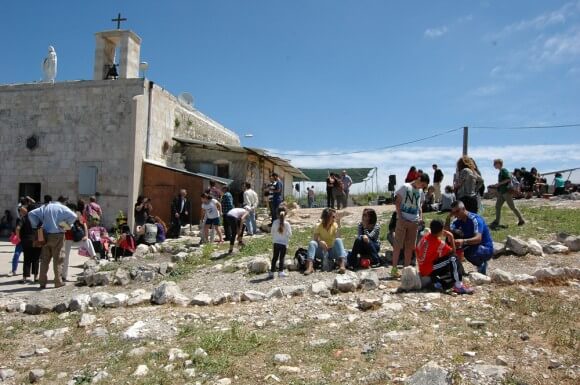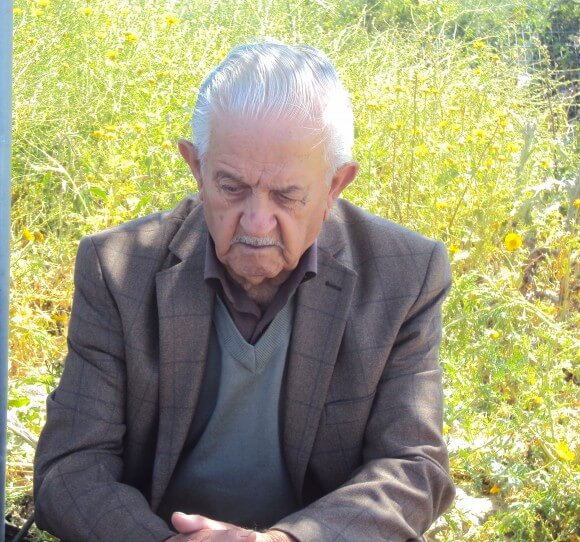
Amir Ashkar lives in a village that was destroyed six decades ago with the exception of a hilltop church where he sleeps and a cemetery where his relatives are interred. Those structures are the only two fully operational spaces in this town with no permanent homes, a little electricity from solar panels, an outdoor shower and just two toilets. Still, Iqrit, located at the northern tip of Israel within eyeshot of Lebanon, is home to Amir and 19 other youth.
“It’s not a struggle to go back home because we all go back home in the end,” said Amir, a 19-year-old cafe worker who spent most of his upbringing in the town of Kafr Yassif. “So what we are trying to make here is to make a living, and to go back living, not just with death,” he continued.
We spoke to Amir during an Easter celebration where hundreds of Palestinians from Iqrit and nearby towns gathered to celebrate the holiday. One Christian Palestinian even braved illegal entry from the West Bank. But the festivities were short-lived. On Wednesday morning two days after the Easter mass, debkah, and concert—the Israeli green patrol arrived and demolished the stage and uprooted plants. “Today the Israeli Authorities arrived to Iqrith and destroyed all the trees, the herbs, the stage we built for the event on Monday,” said Shadia Sbait from the Iqrit Community Association. “The police also destroyed and even took part of the youth beds.”
Amir is part of a group of young people whose forebears come from Iqrit and have enacted on their own terms the aspiration of many Palestinians: the right of return to villages leveled by Israel in the 1940s and 50s. Sitting cross-legged while pulling from a cigarette, Amir said he too would be buried in Iqrit’s cemetery. In the meantime he conducts his life similarly to any other Palestinian citizen of Israel, with the anomaly of living off of the grid under constant Israeli surveillance. In fact, during our visit a drone flew overhead, eventually nose diving not far from where Amir’s grandfather once lived. “People tried to build houses, they demolished. We tried to make even a chicken coop, and they demolished it. We planted trees, they took the trees out,” he told us.
Night-stays in Iqrit began for Amir during an annual summer camp put together by older members of the community. “In the summer camp we said, ‘shit we want to stay living here together,’” said Walaa Sbait, 27, a drama teacher and another returnee of Iqrit (and the nephew of Shadia Sbait). “We imagined when we started having this 18-year experience, of moving back.” The youth first began to set up a permanent camp in Iqrit in August 2012.
Walaa noted Iqrit is still accessible by a dirt road and nothing has been constructed on top of it. He said this was Israel’s “war mistake” in their effort to remove Palestinians permanently from the village. “There is an ‘advantage’ for us as displaced people,” he continued.
Iqrit is a rather unique village in that it hasn’t been re-made into something else by the Jewish state. There are only a handful of the some 570 villages destroyed around the time of Israel’s declaration of independence that are not built over today with new Israeli-Jewish localities, or covered by forestry projects of the Jewish National Fund (JNF). In fact, one ridge in Iqrit where houses used to be is overgrown with the JNF’s iconic conifer trees, which stick out like of marker for demolished Palestinian life because they are generally much taller, and a darker shade green than indigenous trees.

Others originally from Iqrit refer to Amir, Walaa and the other camping youth as the “third generation,” as they are the third generation reared after the entire community was displaced. In November 1948, six months after Israel was officially established, troops arrived to Iqrit, which had put up no resistance during the fighting that broke out from 1947-1949. The Israeli military expelled most of its 490 residents to another Galilee village named Rame. Told they could return in two weeks, Israeli officials instead declared Iqrit a closed military zone. (The Israel Defense Forces did the same to other villages near the Lebanon border.)
The residents, by then Israeli citizens, wanted to return to Iqrit, and appealed to the Israeli Supreme Court—the first legal volley in a decades-long struggle waged within Israel. And in 1951, the judges ruled that Iqrit’s residents should be allowed to return. But on Christmas Eve in 1951, that dream was extinguished. The Israeli Air Force bombed most of Iqrit, though they left the church and cemetery alone.
Amir’s family founded the village around 270 years ago. His 85-year-old grandfather Marrouf, who took us on a winding trek through Iqrit’s ancestral lands, has been present for much of the village’s recent, fraught history.

“I remember every piece,” he said of his destroyed village just before launching down a steep slope from the church to where his house used to stand, with impressive agility. “How can I reach my house!” he laughed before tall grasses that cover the old paths. And if it weren’t for the grass, grazing cows from the nearby Israeli-Jewish town of Shomra would pose a problem.
The cows wore down the remaining foundations with their weighty tread. Until the 1970s a military order deemed Iqrit a closed zone. Marrouf and those of his generation lament that while they were kept away during that time, a rancher from Shomra was able to use the landscape for his cows without being hassled by Israeli authorities.
“When the military government ended [in 1966] we again went to the court to open the church for religious purposes,” said Marrouf, who helped fix up the building. Today the walls look fresh and the ancient stones are reinforced with concrete. He showed us the different wild flowers he used to dye Easter eggs with days before, and a sapling that replaced an unearthed fig tree. Until he was 19, Marrouf farmed tobacco in Iqrit. Today he teaches his grandson and the other youngsters about every inch of history tucked under bushes and shrubs.

Iqrit has had almost continuous inhabitation for over 2000 years and archeological sites are dispersed throughout. And like Amir, Maarouf also stays over night in Iqrit. Last week he slept there two nights. When it rained, he just covered his head with a newspaper and took off for one of his walks.
Marrouf’s instruction to the third generation has forged a deep bond between the earth and the 20 youth who live in Iqrit today. Amir and Walaa, though they work in cities far away, have no intention of leaving for an apartment in Haifa, or really any fixed structure, which would be more comfortable. “This is the dream,” said Walaa before rushing back to the post-mass concert. “My dream is to live here so I can die here. A complete return; a full set.”


Thanks for clarifying that when you say “Zionists,” you mean “Jews.”
One of the Jews interviewed was Ilan Tuma-Shechter, a scion of one of the ancient Jewish families of Peqiin that have a documented unbroken presence in the village for not a mere five centuries (as my family can claim in the Land of Israel) but 2,000 years. He is a perfect example of one of the “Palestinian Arab Jews” who supposedly are the only ones that have a right to live in the country, and whom the anti-Zionist freedom fighters say are part and parcel of the Palestinian people, yet his lineage does not grant him any special dispensation to anti-coexistence radicals like the hotheads who chased him out and who you agree with.
By your logic, obviously since Israeli Jews (and our “Palestinian Jewish” predecessors from 1917-1948) have suffered murderous mob violence and expulsion from places where our ancestors lived (Hebron in 1929, the Old City of Jerusalem in 1948), and then years of terrorism by the relatives of our fellow Israeli citizens of Arab nationality, it would be perfectly understandable for Israeli Jews not to welcome their fellow Israelis who happen to be Arabs into our neighborhoods, as one has to expect that such behavior will “cause a bit of resentment,” per your words. Fortunately, most of us Israeli Jews are enlightened folk, and have no problem living next to our Arab neighbors in such towns as Yafo, Haifa, Akko,
Nazareth-Ilit and Karmiel (the first three locations have always been mixed–the latter two were nearly exclusively Jewish municipalities that have seen a large influx of Israeli-Arab residents in recent years). Sometimes some Israeli Jews are unwelcoming to their fellow Israelis (if they happen to be Arab) in places like Karmiel , naturally I condemn such attitudes, but I’m sure you understand them given that a bit of resentment is understandable considering the way Arabs have acted in the last 100 years or so.
Israelis are very scared. They must feel their world is coming to an end.
Great report, Alex and Allison. btw, the Palestinian commandos behind the 1972 Munich Olympics disaster named their operation after Iqrit and a neighboring Christian village, also ethnically cleansed in the 1947-9 War. The leader of the group, nicknamed Issa, was half Christian and half Jewish.
Iqrit was originally a Jewish-populated town, from the Mishnaic period and was a home to Jews until the Crusaders destroyed it. It was known in Hebrew as Yoqart (יוקרת), and was the home of Yossy deman Yoqart, a sage of the Talmud.
Kefar Yasif, also mentioned in the article, also held a large Jewish population and there were still Jews living there until the early 20th century. There is an ancient and unfortunately neglected Jewish cemetery in Kfar Yasif where the famous rabbi Moshe Haim Luzzzato is buried, along with some of my father’s ancestors, according to what an elderly aunt told my sister.
There are many Arab localities in northern Israel that were once home to vibrant Jewish communities and where Jews are today made to feel unwelcome.
http://www.israeltoday.co.il/NewsItem/tabid/178/nid/22197/Default.aspx?archive=article_title
http://strangeside.com/holy-land-pekiin-jews-constantly-there/
http://www.israelnationalnews.com/News/News.aspx/124232
http://www.ynetnews.com/articles/0,7340,L-3478336,00.html